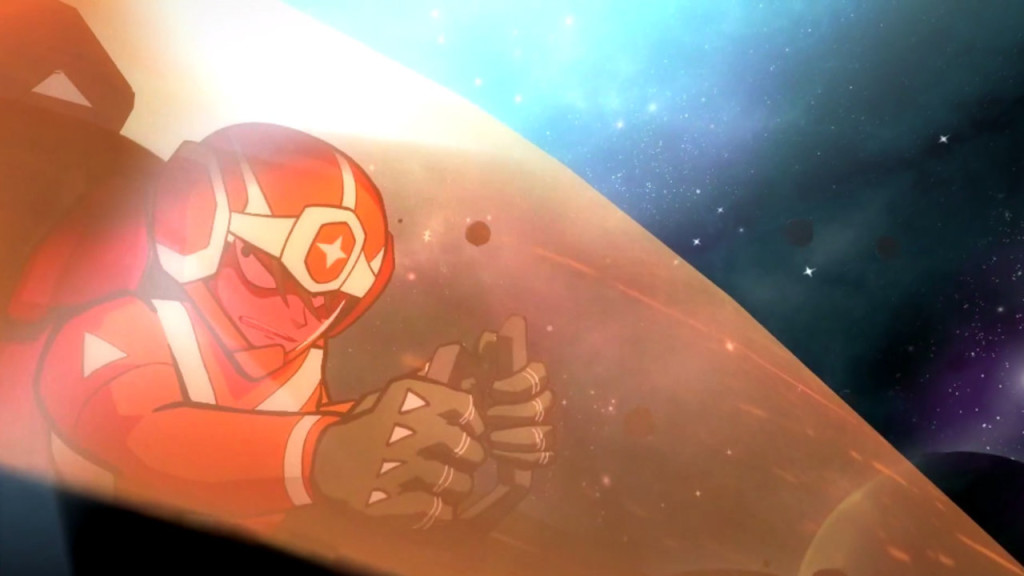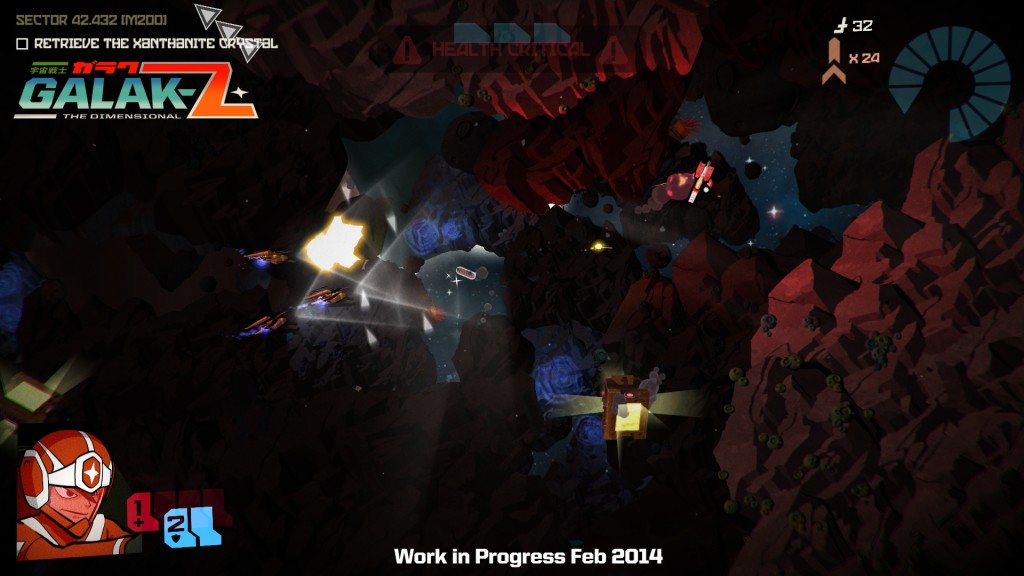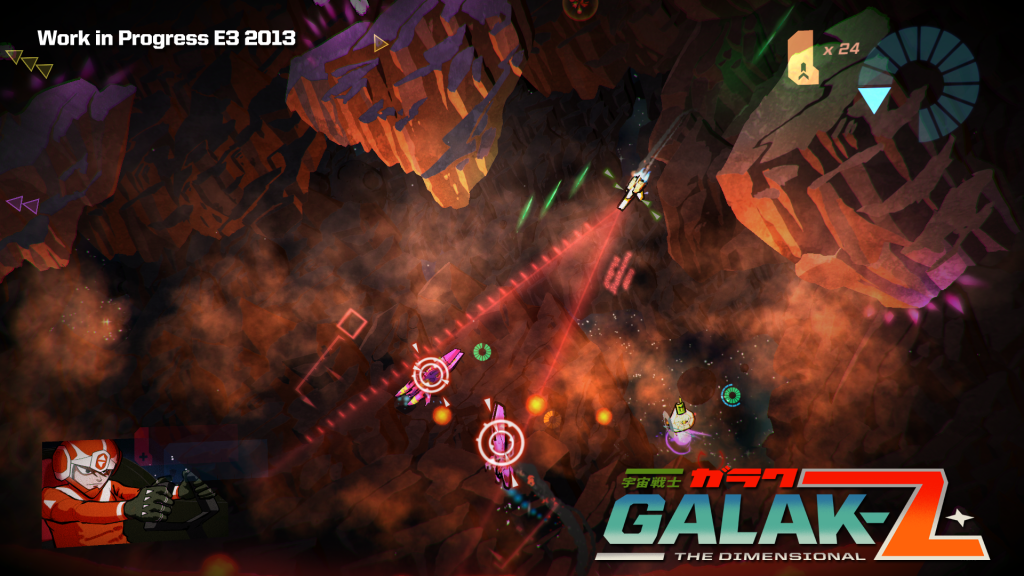Last updated on April 19, 2014
Be anxious for nothing, but in everything by prayer and supplication with thanksgiving let your requests be made known to God.
Philippians 4:6
I’ve got a penchant for shooters. No, not “first person shooters”, just shooters in the traditional arcade sense. They’re not my favorite genre due to lack of time investment and possibly difficulty, but I enjoy them thoroughly nonetheless. In that sense, I know what works and what doesn’t work in a style that become so insanely specialized, so wonderfully full of depth, that many of its developer stalwarts simply up and vanished from their specificity.
Western studios, of course, don’t often take cues from their Japanese forebears except in the most vague of nostalgia-induced senses. Galak-Z: The Dimensional follows more in the tradition of Asteroids than it does in CAVE’s bullet-hell wheelhouse. With a visual style (cel-shaded, if I had to take a guess) cribbed directly from 1970s anime such as Gundam and Macross, it tries to revive a certain generation of animated cartoons while also providing a unique two-dimensional shooting experience. The game seems structured enough, with missions akin to “episodes” and plenty of wonderful nostalgia-bait. A beautiful game deserves some beautiful systems, we hope!
Unlike Asteroids, however, there’s levels to explore and mission objectives to fulfill! Bizarrely enough, I feel the level design takes its cue more from Echo the Dolphin rather than its straightforward shooter ilk. Strange, I know! Galak-Z’s levels are arranged for exploration and unique ship controls rather than the “shoot everything on-screen” objective which Asteroids did so well. There’s plenty of traps and dead-ends to discover, and you must be careful or face many dangers. Explore the level, look for enemy craft and/or alien beings, and destroy them on the way to your objective – just like Sega’s titular dolphin!
Why are you doing this? For stuff, of course! Indie gamers love equipment and weapon setups – similar to Echoes of Eridu (and, let’s say, every popular indie game of the past few years such as Don’t Starve), your setup matters. A tech tree unlocks new abilities over time and allows you to purchase missiles. All of that costs money, and to get money you need to finish missions or blow stuff up. I’m not interested in the game for that in particular, but I understand the inclination for a no-fuss progression system that makes real changes to your game plan. Loot appears in the levels themselves, but they provide a similar function in getting you to explore the levels. In other words, I didn’t find the extrinsic rewards all that compelling, other than in making my ship better.
I find the arcade roots run deeper, though. In the Asteroids vein, the controls contain the meat of the game’s depth. If I had to make a cursory comparison, I’d say it’s a dual analog shooter without the analog (I realize, Raj, that this is wrong, but let me stick with my comparison with sleep backing me up this time). You control the ship’s direction using the left analog stick, and the myriad other buttons control your speed and movement. The direction of your ship’s nose actually determines what many of the controls actually do – just imagine reverse and thrust as inverse analogs of each other which change as you move through a level. There’s also a huge boost button (limited by a boost gauge) for fast movement, and a strafe button which pops your ship to the side (relative to what direction you face, of course).
Using these in concert with each other, effectively dodging and weaving your way through the levels, remains a fun challenge in itself. I love game that make even the most basic movements interesting, and I anticipate how they will use this structure to buttress their combat. Unless, you know, you like ramming into asteroids (ha!) or whatever.
As such, avoiding enemies isn’t as easy as it sounds. Their AI actually runs patrols around the level, and while your first response (MY first response, at least) equals some missiles fired, they don’t force you to do this. The objective of the demo level at PAX East merely required retrieval of a special item, so a stealth approach would work perfectly well. If you do aggro enemies, though you must take them out quickly and efficiently; since they will track your movements, wait too long and they will call for backup! You need to kill them with missiles (homing and tracking, of course), regular shot, and whatever environmental advantages the stage gives you. Also, enemies of warring factions will kill each other if you goad them into it, furthering the possible options for combat.
And apparently, to my surprise, Galak-Z is actually a roguelike! I’m not sure whether my inability to notice this without prior knowledge comes as a complement or a detriment to 17-Bit’s intended goals, but there’s that. If this article gives us any indication, hand-crafted levels weren’t working. The game itself, and the ways levels generate, make it difficult to distinguish at a glance. I found out after the fact, since I only played through a short demo, but that’s literally amazing. Probably, that comes down to the style of game working much better with random generation than we could possibly imagine, or we’re just getting much better at procedural generation. Either way, I’m a little blown away at that fact.
Combine all that, and you’ve got a very, very promising product on your hands. Of course, one short, level-long demo means that I can’t get a good sense of whether the game as a whole works. Just purely on a mechanical level, the controls seem interesting, but will they hold the whole game up? Will procedural generation work the whole way through, or will we see the seams at work when things don’t go exactly as planned? At this point, these questions are impossible to answer.
I am merely a critic, not a prognosticator. I just have to let it go and just accept that I can’t fix anything to my will. I wish for success for Galak-Z, and I hope that all my concerns turn out to be for naught when it does come out. Until then, I’ll wait without anxiety for its eventual release.



